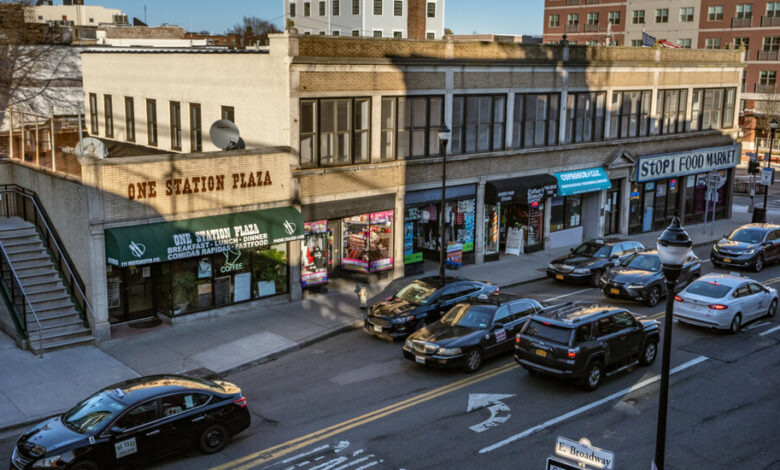Port Chester, N.Y.: A ‘Tiny Little Village’ With a Lot of Development

Hai Yang, 37, lives in a one-bedroom apartment overlooking the Byram River in downtown Port Chester, a 2.4-square-mile village in the town of Rye, in Westchester County. Since moving to the $2,700-a-month apartment a year ago, Mr. Yang has found he can walk to most everything he needs.
The Metro-North train station is a three-minute walk, which makes it easy to head into New York City to visit friends. Happy hour deals and live jazz are right next door, at the Saltaire Oyster Bar. And he doesn’t need a car to hit the local gym.
But Mr. Yang does have a car, so he can commute to his job in Danbury, Conn., where he is an engineering manager in the medical device industry. Finding a place to park in Port Chester is not an issue — particularly compared to his experience in downtown White Plains, N.Y., where he used to live. And the village, in general, is “much less congested,” he said.
Deirdre Curran, 57, moved into a townhouse across from the village’s 20-acre Lyon Park last June. A retired pet sitter and dog walker, Ms. Curran had rented in the village off and on over the years, and appreciates its diversity. “There are a lot of different cultures, and you can get any kind of food you want from Central and South America,” she said.
She paid $515,000 for her two-bedroom home, which is convenient to downtown businesses, major highways and the Westchester County Airport. But while Ms. Curran loves her home’s location, she is increasingly alarmed by the scale and pace of residential development planned for the compact downtown area.
Three large, mixed-use apartment projects are currently under construction. The six-story Tarry Lighthouse, on North Main, will have 209 apartments as well as commercial space. The Magellan, on South Main, will add another 95 apartments in a nine-story, 100-percent electrified building. And 30 Broad, across from the train station, will have 36 apartments above a microbrewery.
These follow the recent completion of Port & Main, a five-story, 80-unit building a block from the train station.
“They want to do all this major development in this tiny little village that does not have the infrastructure to handle it,” Ms. Curran said. “It seems to me like an awful lot of major development in a very short period of time.”
The village has granted conditional site plan approval to projects with a total of more than 2,800 units over the past three years, said Stuart L. Rabin, the village manager. This flurry of development proposals is largely the result of a change in village zoning three years ago designed to encourage the redevelopment and revitalization of Port Chester’s downtown, waterfront and transit-adjacent parcels, he said.
“The village of Port Chester is certainly on the move,” Mr. Rabin said.
But the scale of the proposals has generated considerable public pushback, with some residents expressing concern that towering apartment buildings threaten to overwhelm the historic downtown and price out the many mom-and-pop businesses.
John Allen, an elected member of Port Chester’s board of trustees, said that while the village was “ripe for redevelopment,” given the number of buildings in disrepair, there is a growing sense that the board allowed for “these extraordinary increases for density and asked for very little in return from developers,” including having to meet more of the community’s affordable housing needs.
The board has recently begun to discuss a “narrowly tailored” moratorium on development in order to study whether further changes are needed to the zoning code, he said. A moratorium would not affect projects already under construction.
What You’ll Find
Port Chester is a densely developed village of 31,000 that “sprang to life at the crossroads of various transportation options,” including a small harbor on Long Island Sound and rail lines into New York City, said Gregg Hamilton, a retired Manhattan transplant who runs the Sustainable Port Chester Alliance.
Some remnants of its 19th- and early 20th-century industrial heyday remain. The Simons Manufacturing Company building, which once housed a major textile maker, is now a loft-style office complex. And the former headquarters of the Life Savers Candy Company now houses condominiums.
In the walkable downtown area, beauty salons, restaurants and grocery stores catering to the village’s majority-Hispanic population line the main thoroughfares of Westchester Avenue and North and South Main. (According to census data, the village population is 64 percent Hispanic, 28 percent white, 5 percent Black and 1 percent Asian.) Two large commercial bakeries — Neri’s and J.J. Cassone — are major employers.
Modest single-family and multifamily homes set close to the hilly streets surround the downtown. To the north, the streets are wider, and homes are set farther apart in suburban-style neighborhoods.
A 15-acre abandoned hospital campus on the edge of downtown, once a target for development by Starwood Capitol Group, is now set for redevelopment by Rose Associates and BedRock Real Estate Partners. The companies have received site plan approval for nearly 1,000 housing units, including 200 age-restricted units, and expect to begin demolition of the existing buildings by spring, said Richard Shea, a project spokesman.
The nonprofit Carver Center supports the community’s lower-income and immigrant populations with a food bank, citizenship classes, after-school programming and a teen center.
What You’ll Pay
As in most of Westchester County, housing inventory in Port Chester is very low and it is a seller’s market, said Thomas E. Consaga, the broker-owner at Re/Max Ace Realty. Competition is particularly high among first-time buyers because home prices are considerably lower than in surrounding suburbs like Greenwich, Conn., and Rye, N.Y., he said.
The median sale price for a single-family home in Port Chester last year was $645,000, almost 10 percent higher than in 2021. By comparison, the 2022 median sale price in neighboring Greenwich was almost $3 million.
As of last week, there were only about 20 single-family homes on the market, Mr. Consaga said. They ranged from a three-bedroom colonial built in 1955, listed for $475,000, to a six-bedroom colonial built in 1900, listed for $1.34 million.
The median sale price for a condominium last year was $347,500; for a cooperative, it was $118,000, he said.
Almost 60 percent of households in Port Chester are renter-occupied, according to census data. Over the last 12 months, the median rent for a two-bedroom was $2,800, Mr. Consaga said.
That figure factors in the many older, multifamily homes in the village, but rents at the new apartment buildings are considerably higher. At Port & Main, which has a rooftop terrace and a fitness center, a 400-square-foot studio starts at $2,300 a month and an 1,150-square-foot, two-bedroom rents for more than $4,000, said Whitney Okun, who runs a development group at Houlihan Lawrence that is overseeing the project.
The Vibe
The Capitol Theater, on Westchester Avenue, books big-name artists that draw music lovers from throughout the region. Concertgoers swarm the wide array of downtown restaurants, including El Tio, Bartaco, T&J Restaurant and Pizzeria, and Panka Peruvian Bistro.
The parking lot at the Waterfront at Port Chester mall is jammed on weekends with shoppers stocking up at Costco. The mall’s other draw is a 14-screen AMC movie theater.
The growing arts scene includes the well-established Clay Art Center, a large complex with numerous pottery studios and classrooms, as well as a public gallery, and Ice Cream Social, a relatively new space where artists working in various media can rent private or shared studios.
“Port Chester is my hometown, so it’s kind of a dream to be able to support the artists who are here,” said Jennifer Cacciola, an artist and a founder of the center, who moved to Connecticut from Brooklyn shortly before the pandemic.
The Schools
The Port Chester-Rye Union Free School District serves students in all of Port Chester and about a third of the neighboring village of Rye Brook. Of the roughly 4,500 students districtwide, about 83 percent identify as Hispanic or Latino, 12 percent as white, 3 percent as Black and 2 percent as Asian, according to state education data.
The district contracts with Corpus Christi Holy Rosary School to provide a prekindergarten program for 4-year-olds. Students in kindergarten through fifth grade attend one of four elementary schools; those in sixth through eighth grade attend Port Chester Middle School.
Port Chester High School is on a 20-acre campus bordering Rye Brook, with about 1,600 students. Academic offerings include Advanced Placement and International Baccalaureate courses. The four-year graduation rate for the class of 2022 was 88 percent.
The Commute
Port Chester station, on Metro-North’s New Haven line, is in the heart of downtown. The ride to Grand Central during peak commuting times takes just under an hour; the one-way fare is $13.75, and a monthly pass is $270.
Westchester County’s Bee-Line bus service offers transportation from Port Chester to Rye, Harrison, Mamaroneck, Larchmont, New Rochelle and the Bronx.
The CT Transit 311 bus, operated by the Connecticut Department of Transportation, runs throughout the day between Liberty Square in Port Chester and Stamford, Conn., with additional stops in Greenwich, Conn.
The History
Port Chester’s sizable Hispanic and Latino population has been growing for decades, ever since Cuban refugees fleeing Fidel Castro’s rule settled in Port Chester to work in the factories in the 1960s, according to a New York Times account. As the factories closed, more immigrants from throughout Central and South America settled in the working-class village, opening restaurants and servicing the affluent suburbs as landscapers, day laborers, house cleaners and child-care providers. The population growth hasn’t been without tensions: In 2009, a federal judge ordered the village to adopt a new voting system that would give the Hispanic and Latino population a fairer opportunity to elect one of their own to the board of trustees. Luis Marino, a Peruvian immigrant, was elected to the board in 2010 and is now the village’s mayor.
For weekly email updates on residential real estate news, sign up here.
Source link






